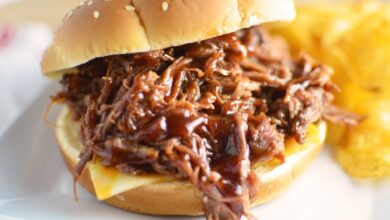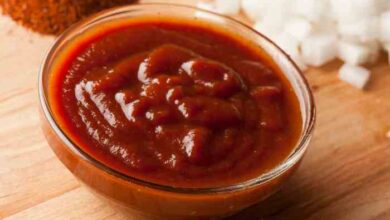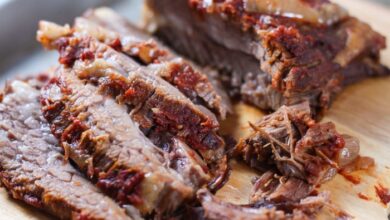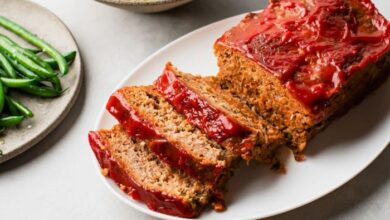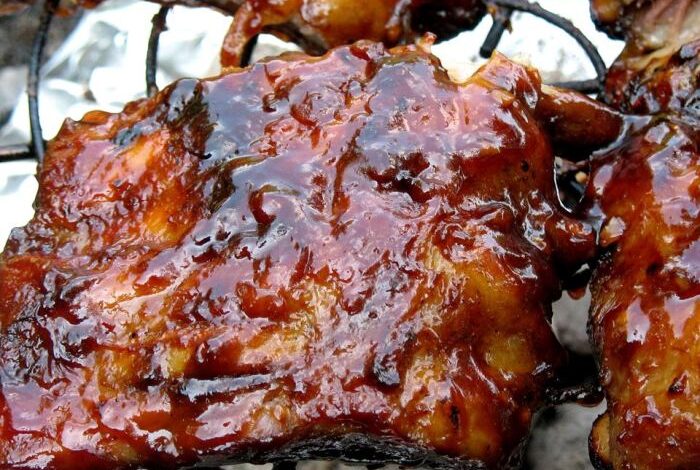
Southern Grilled Barbecued Ribs: A Taste of Tradition
Southern grilled barbecued ribs are more than just a delicious meal; they’re a cultural experience. From the smoky aroma that fills the air to the tender, fall-off-the-bone meat, every bite tells a story. This iconic dish is steeped in history, rooted in the traditions of the American South, and a testament to the power of slow cooking and flavorful ingredients.
Let’s dive into the world of southern barbecue, exploring its origins, techniques, and the irresistible allure of this culinary treasure.
The history of southern barbecue is as rich and complex as the flavors themselves. African American culture played a pivotal role in shaping this tradition, with enslaved people using their ingenuity and knowledge of cooking techniques to create dishes that would become synonymous with the South.
From the humble beginnings of cooking over open fires to the refined art of smoking ribs, southern barbecue has evolved over centuries, becoming a culinary symbol of community and shared experiences.
The History of Southern BBQ: Southern Grilled Barbecued Ribs
The origins of barbecue in the Southern United States are deeply intertwined with the history of the region, encompassing the influence of indigenous populations, European settlers, and African American culinary traditions. The word “barbecue” itself is believed to have originated from the Taíno word “barbacoa,” referring to a raised wooden framework used by the indigenous people of the Caribbean for cooking meat over fire.
The Role of African American Culture
African American culture played a pivotal role in shaping the distinctive flavors and techniques of Southern barbecue. Enslaved Africans brought with them their own culinary traditions, which blended with the European methods of cooking meat over fire. They developed innovative ways to utilize readily available ingredients and resources, such as smoking meats with hickory wood for a smoky flavor, using vinegar-based sauces, and incorporating spices like paprika and black pepper.
This fusion of cultures led to the creation of a unique style of barbecue that became synonymous with the South.
Early Barbecue Traditions and Techniques
Early barbecue traditions in the South were often communal events, with whole animals like pigs and cattle being cooked over open fires for extended periods. The slow-cooking process, using hardwoods like hickory, oak, or pecan, imparted a rich, smoky flavor to the meat.
Southern grilled barbecued ribs are a classic comfort food, smoky and tender, perfect for a backyard barbecue. But sometimes, you crave something lighter and more comforting, like a warm bowl of chicken mushroom and rice soup. It’s a simple yet satisfying meal that warms the soul, leaving you feeling content and ready for another round of those ribs.
These early barbecue feasts were typically held in conjunction with social gatherings, festivals, and celebrations, bringing communities together.
Southern grilled barbecued ribs are a classic for a reason – they’re smoky, tender, and utterly delicious. But sometimes, you crave something a little lighter and easier, like a comforting impossibly easy chicken pot pie. That’s where the magic of leftovers comes in – those ribs can easily be transformed into a hearty pot pie filling for a satisfying, one-pan meal.
The Evolution of Barbecue Styles
Over time, various regional barbecue styles emerged throughout the South, each with its own distinctive flavors and techniques. These styles reflect the unique ingredients and culinary traditions of each region.
- Carolina Barbecue: Known for its vinegar-based sauce, typically made with vinegar, black pepper, and salt.
- Texas Barbecue: Characterized by its use of dry rubs and a smoky flavor achieved by cooking over mesquite wood.
- Memphis Barbecue: Famous for its sweet and tangy sauce, often made with tomato paste, sugar, and spices.
- Kansas City Barbecue: Features a thick, sweet sauce with a blend of tomato ketchup, molasses, and spices.
The Art of Smoking Ribs
The art of smoking ribs is a true culinary experience, requiring patience, attention to detail, and a deep understanding of the process. Smoking ribs is not simply about cooking meat; it’s about transforming it into a tender, flavorful masterpiece. The slow, low-temperature cooking process allows the smoke to permeate the meat, resulting in a unique smoky aroma and a tender, juicy texture.
Types of Wood for Smoking Ribs
The type of wood used for smoking ribs significantly influences the flavor profile. Different woods impart distinct aromas and flavors, ranging from subtle hints to robust notes.
- Hickory:A popular choice for ribs, hickory wood provides a strong, smoky flavor with a hint of nuttiness. It’s ideal for imparting a robust flavor to ribs.
- Oak:Oak wood offers a balanced flavor profile with a slightly sweet and earthy aroma. It’s a versatile option that complements a wide range of meats.
- Mesquite:Mesquite wood produces a bold, smoky flavor with a hint of sweetness. It’s often used for grilling and smoking, adding a distinct, robust character to the meat.
- Apple:Apple wood provides a subtle, sweet, and fruity aroma, making it a good choice for lighter meats like poultry. It adds a delicate touch to ribs without overpowering their natural flavor.
- Cherry:Cherry wood imparts a sweet, fruity flavor with a hint of tartness. It’s often used for smoking salmon and other delicate meats, but can also add a subtle sweetness to ribs.
Step-by-Step Guide to Smoking Ribs
Smoking ribs is a multi-step process that requires careful preparation and attention to detail. The following steps provide a comprehensive guide to achieving succulent, flavorful ribs:
- Prepare the Ribs:Begin by removing the membrane from the back of the ribs. This membrane can prevent the smoke from penetrating the meat, resulting in tough ribs. Trim any excess fat and apply a dry rub to season the ribs thoroughly.
- Preheat the Smoker:Preheat your smoker to a low temperature, typically between 225°F and 250°F. This low and slow cooking method is essential for achieving tender, flavorful ribs.
- Place the Ribs in the Smoker:Place the ribs in the smoker, ensuring they are spaced evenly to allow for proper smoke circulation. Maintain a consistent temperature throughout the cooking process.
- Monitor and Add Smoke:Monitor the temperature of the smoker regularly and add wood chips or chunks as needed to maintain a steady smoke flow.
- Wrap the Ribs:After a few hours of smoking, wrap the ribs in aluminum foil to help them retain moisture and accelerate the cooking process. This step is crucial for achieving tender, melt-in-your-mouth ribs.
- Unwrap and Glaze:After the ribs are fully cooked and tender, unwrap them and brush them with a barbecue sauce of your choice. This step adds a final layer of flavor and creates a delicious, sticky glaze.
- Rest and Serve:Allow the ribs to rest for at least 10 minutes before slicing and serving. This resting period allows the juices to redistribute, resulting in more tender and flavorful ribs.
Temperature and Time Control
Maintaining the correct temperature and cooking time is crucial for achieving perfect smoked ribs. The ideal temperature for smoking ribs is between 225°F and 250°F.
Cooking time varies depending on the size and thickness of the ribs, but generally takes 4-6 hours for a full rack of ribs.
The low and slow cooking method allows the smoke to penetrate the meat, resulting in a tender, flavorful, and juicy product.
The Perfect Rub and Sauce
The heart of any good barbecue is the rub and sauce. These two components are what truly bring out the unique flavor profile of Southern barbecue. They are not just about adding flavor; they also play a crucial role in creating a beautiful, crispy bark on the ribs while keeping them juicy and tender.
Dry Rubs vs. Wet Rubs
Dry rubs are a mixture of spices, herbs, and sometimes sugar, applied directly to the meat before cooking. They create a flavorful crust on the outside of the ribs. Wet rubs, on the other hand, contain liquid ingredients, such as oil or vinegar, that help the spices adhere to the meat and create a more intense flavor.
The Importance of Spices, Southern grilled barbecued ribs
The spices used in barbecue rubs and sauces are what create the distinct flavor profile of Southern barbecue.
- Salt: Salt is essential for enhancing the flavor of the meat and helping to retain moisture. It also aids in the browning process.
- Pepper: Black pepper adds a bit of heat and a slightly earthy flavor.
- Paprika: Paprika provides a smoky flavor and a vibrant red color to the rub.
- Garlic Powder: Garlic powder adds a pungent aroma and flavor that complements the richness of the meat.
- Onion Powder: Onion powder adds a savory and sweet flavor that balances the other spices.
- Chili Powder: Chili powder adds heat and a complex flavor profile. The type of chili powder used can vary, from mild to hot, depending on the desired level of heat.
- Cumin: Cumin adds an earthy, slightly bitter flavor that complements the smoky notes of barbecue.
- Brown Sugar: Brown sugar adds sweetness and helps to create a caramelized crust on the ribs.
- Cayenne Pepper: Cayenne pepper adds a fiery kick to the rub.
- Mustard Powder: Mustard powder adds a tangy flavor and helps to create a crust on the ribs.
- Oregano: Oregano adds a slightly bitter and earthy flavor that complements the other spices.
- Thyme: Thyme adds a warm and earthy flavor that complements the other spices.
Classic Southern Barbecue Rub Recipe
Ingredients:
- 1/2 cup kosher salt
- 1/4 cup black pepper
- 1/4 cup paprika
- 2 tablespoons garlic powder
- 2 tablespoons onion powder
- 1 tablespoon chili powder
- 1 tablespoon cumin
- 1 tablespoon brown sugar
- 1 teaspoon cayenne pepper
- 1 teaspoon mustard powder
- 1 teaspoon oregano
- 1 teaspoon thyme
Instructions:
- Combine all ingredients in a bowl and mix well.
- Rub the mixture generously onto the ribs, ensuring all surfaces are covered.
- Let the ribs sit in the refrigerator for at least 30 minutes, allowing the rub to penetrate the meat.
Classic Southern Barbecue Sauce Recipe
Ingredients:
- 1 cup ketchup
- 1/2 cup apple cider vinegar
- 1/4 cup brown sugar
- 1/4 cup Worcestershire sauce
- 2 tablespoons Dijon mustard
- 1 tablespoon garlic powder
- 1 tablespoon onion powder
- 1 teaspoon chili powder
- 1 teaspoon black pepper
- 1/2 teaspoon cayenne pepper
Instructions:
- Combine all ingredients in a saucepan over medium heat.
- Bring to a simmer, stirring constantly, until the sauce thickens slightly.
- Reduce heat to low and simmer for 15 minutes, or until the sauce has reached the desired consistency.
- Remove from heat and let cool slightly before using.
Regional Variations
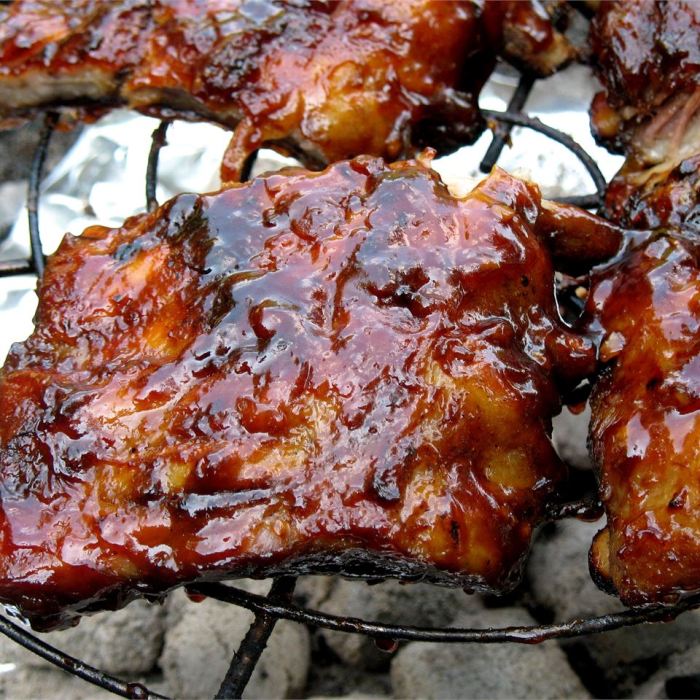
The Southern barbecue landscape is a tapestry woven with regional variations, each boasting its own unique flavors, techniques, and traditions. From the vinegar-based sauces of the Carolinas to the smoky, slow-cooked meats of Texas, exploring these regional differences reveals the diverse and rich history of Southern barbecue.
The Carolinas
The Carolinas are known for their distinct vinegar-based barbecue sauces, which are typically thin and tangy.
North Carolina
North Carolina barbecue is characterized by its use of a vinegar-based sauce, often with a touch of mustard. The most popular meat in North Carolina is pork, typically pulled from the shoulder and served on a bun with coleslaw.
South Carolina
South Carolina barbecue is similar to North Carolina, but the sauce tends to be sweeter and often includes a touch of tomato. The most popular meat in South Carolina is also pork, but it is typically served whole, with the ribs and shoulder cooked together.
Regional Differences
- Sauce:North Carolina barbecue sauces are typically thin and vinegar-based, with a touch of mustard. South Carolina barbecue sauces are often sweeter and include a touch of tomato.
- Meat:Both North Carolina and South Carolina barbecue primarily use pork, but North Carolina typically serves pulled pork, while South Carolina serves whole pork.
- Side Dishes:Common side dishes in both states include coleslaw, hushpuppies, and baked beans.
Texas
Texas barbecue is known for its smoky, slow-cooked meats, typically cooked over a wood fire.
Central Texas
Central Texas barbecue is characterized by its use of a dry rub and a thin, smoky sauce. The most popular meat in Central Texas is brisket, which is often served with a side of white bread and pickles.
East Texas
East Texas barbecue is similar to Central Texas, but the sauce is often thicker and sweeter.
Southern grilled barbecued ribs are a classic for a reason – smoky, tender, and dripping with delicious sauce. But sometimes you want something a little lighter and creamy, and that’s where a homemade alfredo sauce comes in. This recipe for better than olive garden alfredo sauce is truly amazing, and it pairs perfectly with the richness of the ribs for a well-rounded meal.
West Texas
West Texas barbecue is known for its use of a dry rub and a simple, vinegar-based sauce.
Regional Differences
- Sauce:Central Texas barbecue sauces are typically thin and smoky, while East Texas barbecue sauces are often thicker and sweeter. West Texas barbecue sauces are simple and vinegar-based.
- Meat:Brisket is the most popular meat in Central Texas, while sausage and ribs are also common. In East Texas, brisket, pork ribs, and sausage are popular. In West Texas, brisket is the most popular meat, followed by ribs and sausage.
- Side Dishes:Common side dishes in Texas include potato salad, coleslaw, and baked beans.
Memphis
Memphis barbecue is known for its dry rub and its sweet, tangy sauce. The most popular meat in Memphis is pork ribs, which are often cooked over hickory wood and served with a side of coleslaw and potato salad.
Kansas City
Kansas City barbecue is known for its thick, sweet sauce and its use of a variety of meats, including pork ribs, brisket, and chicken.
Other Regions
Other Southern states have their own unique barbecue traditions. For example, Alabama barbecue is known for its white sauce, while Georgia barbecue is known for its use of mustard-based sauce.
Side Dishes and Beverages
A barbecue feast isn’t complete without a spread of delicious side dishes and refreshing beverages. Southern barbecue is known for its hearty, flavorful sides that complement the smoky, tender ribs. The right drinks help to balance the richness of the meat and enhance the overall dining experience.
Classic Southern Barbecue Side Dishes
These dishes are staples of any Southern barbecue gathering, offering a delightful balance of textures and flavors.
- Macaroni and Cheese:This creamy, cheesy comfort food is a must-have at any barbecue. A classic Southern version often includes a blend of sharp cheddar and Colby cheeses, along with a touch of paprika for a hint of spice.
- Collard Greens:These leafy greens are cooked slowly with smoked meats, onions, and garlic, resulting in a rich, earthy flavor. They are often seasoned with a splash of vinegar for a tangy bite.
- Potato Salad:A creamy potato salad, often made with mayonnaise, mustard, and a touch of sweetness, provides a refreshing contrast to the smoky ribs.
- Baked Beans:Slow-cooked baked beans, seasoned with molasses, brown sugar, and bacon, offer a sweet and smoky flavor that pairs well with the ribs.
- Cornbread:A crumbly, slightly sweet cornbread is a perfect accompaniment to barbecue. It can be served warm with butter or honey.
Pairing Barbecue with Beverages
The choice of beverage can significantly impact the overall enjoyment of a barbecue meal. Consider the following factors when selecting drinks:
- The Barbecue Style:The type of barbecue sauce and the overall flavor profile of the ribs will influence the best beverage pairings.
- Personal Preferences:Ultimately, the most important factor is to choose drinks that you enjoy.
- The Occasion:A casual gathering might call for simple drinks, while a formal event might warrant more sophisticated options.
Recommended Side Dishes and Beverages
Here’s a table showcasing recommended side dishes and beverages for different barbecue styles:
| Barbecue Style | Recommended Side Dishes | Recommended Beverages |
|---|---|---|
| Texas-Style Barbecue | Potato Salad, Coleslaw, Onion Rings | Ice-Cold Beer, Sweet Tea |
| Carolina-Style Barbecue | Collard Greens, Macaroni and Cheese, Hushpuppies | Vinegar-Based Barbecue Sauce, Iced Tea |
| Memphis-Style Barbecue | Baked Beans, Cornbread, Pulled Pork Sandwiches | Sweet Tea, Lemonade |
| Kansas City-Style Barbecue | Baked Beans, Coleslaw, Potato Salad | Beer, Root Beer, Sweet Tea |
The Social Aspect of BBQ
Barbecue in the South is more than just a meal; it’s a deeply ingrained social tradition. The act of slow-smoking meat over wood, sharing a meal with friends and family, and creating lasting memories has become a cornerstone of Southern culture.
Barbecue’s Role in Community Gatherings and Celebrations
Barbecue is the quintessential gathering food in the South. From backyard cookouts to large-scale festivals, barbecue brings people together to celebrate life’s joys and sorrows. The aroma of smoked meat wafting through the air creates an inviting atmosphere, prompting neighbors to share stories and laughter while enjoying the delicious food.
Popular Barbecue Events
- Barbecue Competitions:These events are a major attraction in many Southern towns, drawing competitors and spectators from across the region. Judges evaluate the ribs, brisket, pulled pork, and chicken based on factors like tenderness, flavor, and presentation. The winners are often awarded prizes and bragging rights, solidifying their place in the barbecue community.
- Festivals:Numerous festivals throughout the South are dedicated to celebrating the art of barbecue. These events feature live music, craft vendors, and, of course, ample opportunities to sample and enjoy different barbecue styles. Some popular examples include the Memphis in May International Festival, the World Championship Barbecue Cooking Contest in Kansas City, and the Texas State BBQ Championship.
- Church Suppers and Fundraisers:Barbecue is often the centerpiece of church suppers and fundraisers, where community members come together to support their local organizations. These events are a testament to the strong bonds of Southern communities, as people gather to enjoy a shared meal and contribute to a worthy cause.

